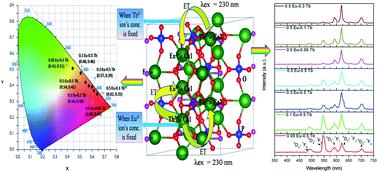Our official English website, www.x-mol.net, welcomes your
feedback! (Note: you will need to create a separate account there.)
Unraveling the site-specific energy transfer driven tunable emission characteristics of Eu3+ & Tb3+ co-doped Ca10(PO4)6F2 phosphors
RSC Advances ( IF 3.9 ) Pub Date : 2021-09-22 , DOI: 10.1039/d1ra04941k Nimai Pathak 1 , Bhagyalaxmi Chundawat 2 , Pratik Das 3 , Pampa Modak 4 , Brindaban Modak 5, 6
RSC Advances ( IF 3.9 ) Pub Date : 2021-09-22 , DOI: 10.1039/d1ra04941k Nimai Pathak 1 , Bhagyalaxmi Chundawat 2 , Pratik Das 3 , Pampa Modak 4 , Brindaban Modak 5, 6
Affiliation

|
In this study we have explored Ca10(PO4)6F2 as host to develop a variety of phosphor materials with tunable emission and lifetime characteristics based on Eu3+ and Tb3+ as co-dopant ions and the energy transfer process involved with them. The energy transfer from the excited state of Tb3+ ion to the 5D0 state of Eu3+ makes it possible to tune the colour characteristics from yellow to orange to red. Further, such energy transfer process is highly dependent on the concentration of Eu3+ and Tb3+ ions and their site-selective distribution among the two different Ca-sites (CaO9 and CaO6F) available. We have carried out DFT based theoretical calculation for both Eu3+ and Tb3+ ions in order to understand their distribution. It was observed that in cases of co-doped sample, Tb3+ ions prefer to occupy the Ca2 site in the CaO6F network while Eu3+ ions prefer Ca1 site in the CaO9 network. This distribution has significant impact on the lifetime values and the energy transfer process as observed in the experimental photoluminescence lifetime values. We have observed that for the 1st series of compounds, wherein the concentration Tb3+ ions are fixed, the energy transfer from Tb3+ ion at Ca2 site to Eu3+ ion at Ca1 site is dominating (Tb3+@Ca2 → Eu3+@Ca1). However, for the 2nd series of compounds, wherein the concentration Eu3+ ions are fixed, the energy transfer process was found to occur from the excited Tb3+ ion at Ca1 site to Eu3+ ions at both Ca1 and Ca2 (Tb3+@Ca1 → Eu3+@Ca1 and Tb3+@Ca1 → Eu3+@Ca2). This is the first reports of its kind on site-specific energy transfer driven colour tunable emission characteristics in Eu3+ and Tb3+ co-doped Ca10(PO4)6F2 phosphor and it will pave the way for the future development of effective colour tunable phosphor materials based on a single host and same co-dopant ions.
中文翻译:

揭示 Eu3+ 和 Tb3+ 共掺杂 Ca10(PO4)6F2 荧光粉的位点特定能量转移驱动的可调谐发射特性
在这项研究中,我们探索了以 Ca 10 (PO 4 ) 6 F 2为主体,以基于 Eu 3+和 Tb 3+作为共掺杂离子以及所涉及的能量转移过程开发各种具有可调发射和寿命特性的荧光粉材料跟他们。从Tb 3+离子的激发态到Eu 3+的5 D 0态的能量转移使得调整从黄色到橙色到红色的颜色特征成为可能。此外,这种能量转移过程高度依赖于Eu 3+和Tb 3+的浓度。离子及其在可用的两个不同 Ca 位点(CaO 9和 CaO 6 F)之间的位点选择性分布。我们已经对 Eu 3+和 Tb 3+离子进行了基于 DFT 的理论计算,以了解它们的分布。据观察,在共掺杂样品的情况下,Tb 3+离子更倾向于占据CaO 6 F 网络中的Ca2 位点,而Eu 3+离子更倾向于CaO 9网络中的Ca1 位点。如在实验光致发光寿命值中观察到的,这种分布对寿命值和能量转移过程有显着影响。我们观察到,对于第1系列化合物,其中Tb 3+离子浓度固定,能量从Ca2位Tb 3+ 离子向Ca1位Eu 3+离子转移为主(Tb 3+ @ Ca2 → Eu 3+ @Ca1)。然而,对于第二系列化合物,其中Eu 3+离子的浓度是固定的,发现能量转移过程发生在Ca1 位的激发Tb 3+离子到Ca1 和Ca2 的Eu 3+离子(Tb 3+ @Ca1 → Eu 3+ @Ca1 和 Tb 3+ @Ca1 → Eu 3+@Ca2)。这是首次报道Eu 3+和Tb 3+共掺杂Ca 10 (PO 4 ) 6 F 2荧光粉的位点特定能量转移驱动的颜色可调发射特性,将为未来的发展铺平道路基于单一主体和相同共掺杂离子的有效颜色可调荧光粉材料。
更新日期:2021-09-22
中文翻译:

揭示 Eu3+ 和 Tb3+ 共掺杂 Ca10(PO4)6F2 荧光粉的位点特定能量转移驱动的可调谐发射特性
在这项研究中,我们探索了以 Ca 10 (PO 4 ) 6 F 2为主体,以基于 Eu 3+和 Tb 3+作为共掺杂离子以及所涉及的能量转移过程开发各种具有可调发射和寿命特性的荧光粉材料跟他们。从Tb 3+离子的激发态到Eu 3+的5 D 0态的能量转移使得调整从黄色到橙色到红色的颜色特征成为可能。此外,这种能量转移过程高度依赖于Eu 3+和Tb 3+的浓度。离子及其在可用的两个不同 Ca 位点(CaO 9和 CaO 6 F)之间的位点选择性分布。我们已经对 Eu 3+和 Tb 3+离子进行了基于 DFT 的理论计算,以了解它们的分布。据观察,在共掺杂样品的情况下,Tb 3+离子更倾向于占据CaO 6 F 网络中的Ca2 位点,而Eu 3+离子更倾向于CaO 9网络中的Ca1 位点。如在实验光致发光寿命值中观察到的,这种分布对寿命值和能量转移过程有显着影响。我们观察到,对于第1系列化合物,其中Tb 3+离子浓度固定,能量从Ca2位Tb 3+ 离子向Ca1位Eu 3+离子转移为主(Tb 3+ @ Ca2 → Eu 3+ @Ca1)。然而,对于第二系列化合物,其中Eu 3+离子的浓度是固定的,发现能量转移过程发生在Ca1 位的激发Tb 3+离子到Ca1 和Ca2 的Eu 3+离子(Tb 3+ @Ca1 → Eu 3+ @Ca1 和 Tb 3+ @Ca1 → Eu 3+@Ca2)。这是首次报道Eu 3+和Tb 3+共掺杂Ca 10 (PO 4 ) 6 F 2荧光粉的位点特定能量转移驱动的颜色可调发射特性,将为未来的发展铺平道路基于单一主体和相同共掺杂离子的有效颜色可调荧光粉材料。











































 京公网安备 11010802027423号
京公网安备 11010802027423号